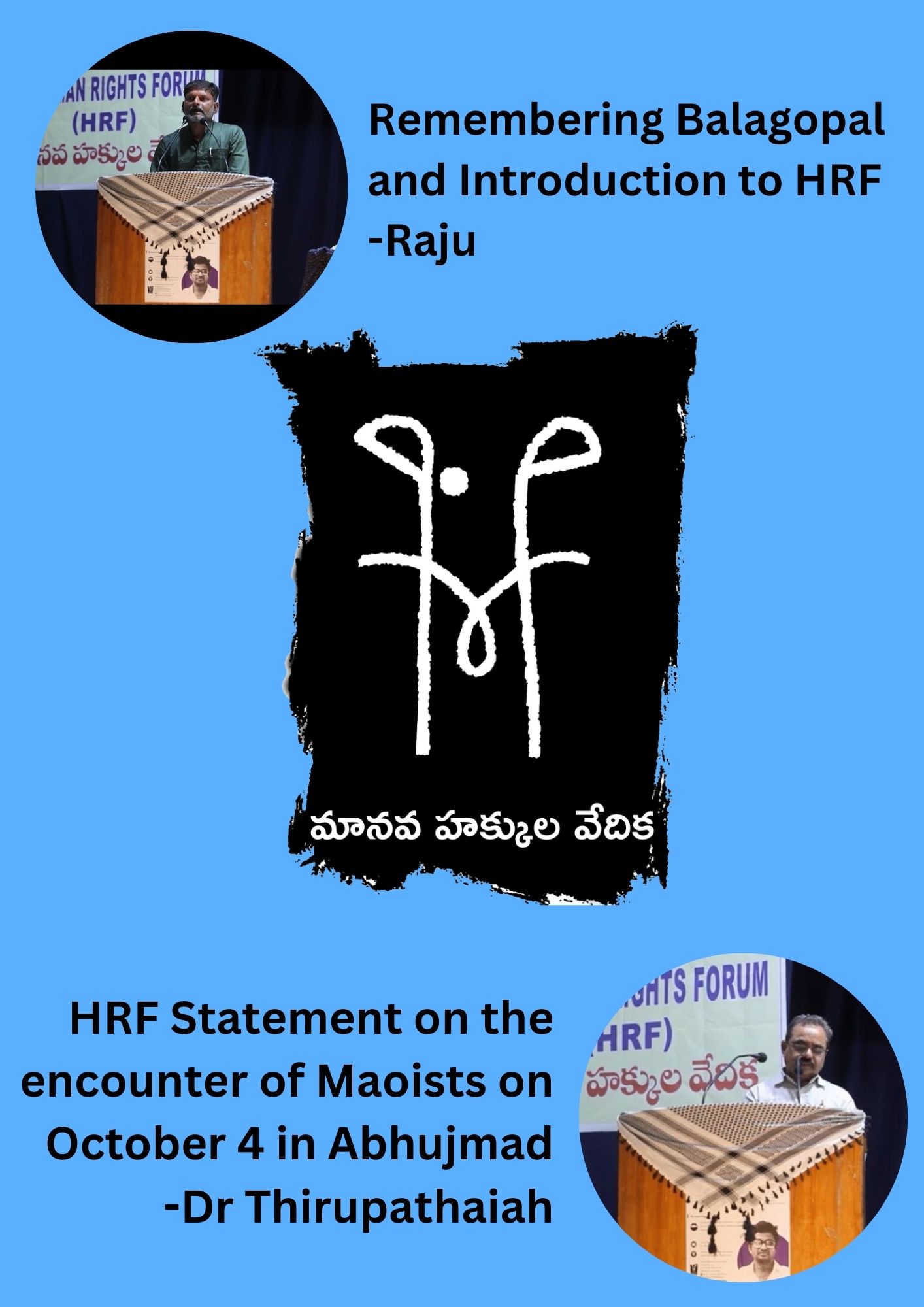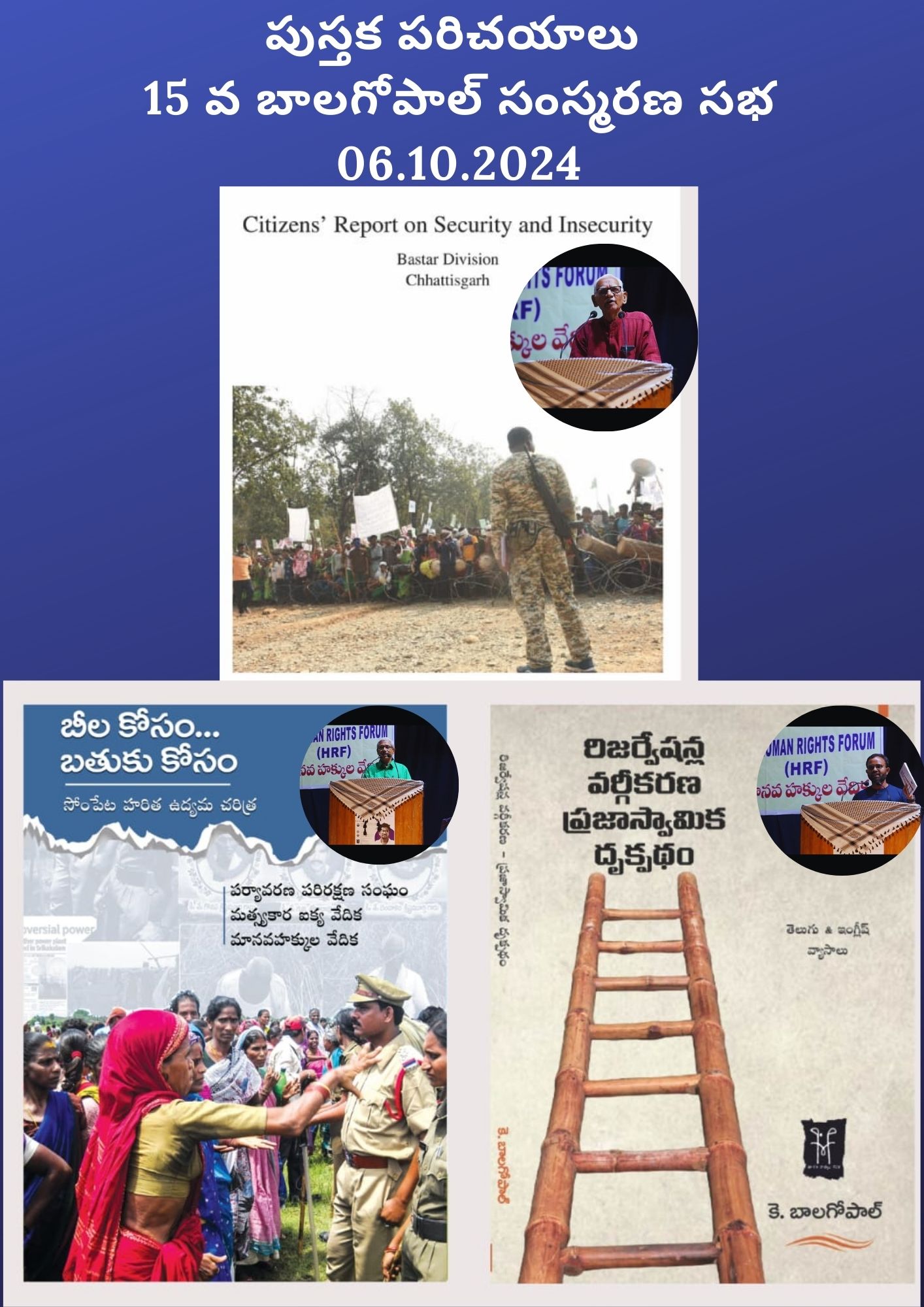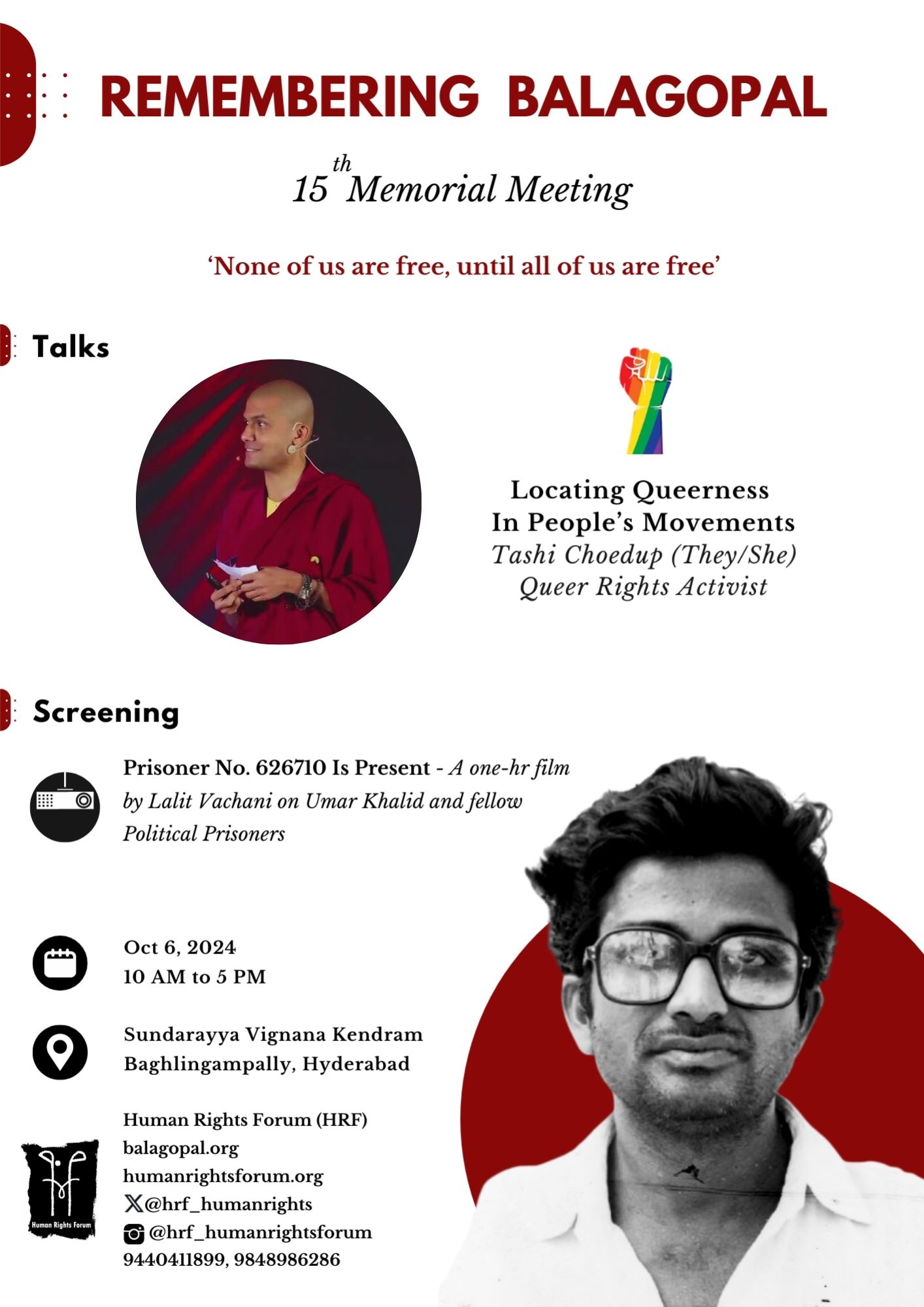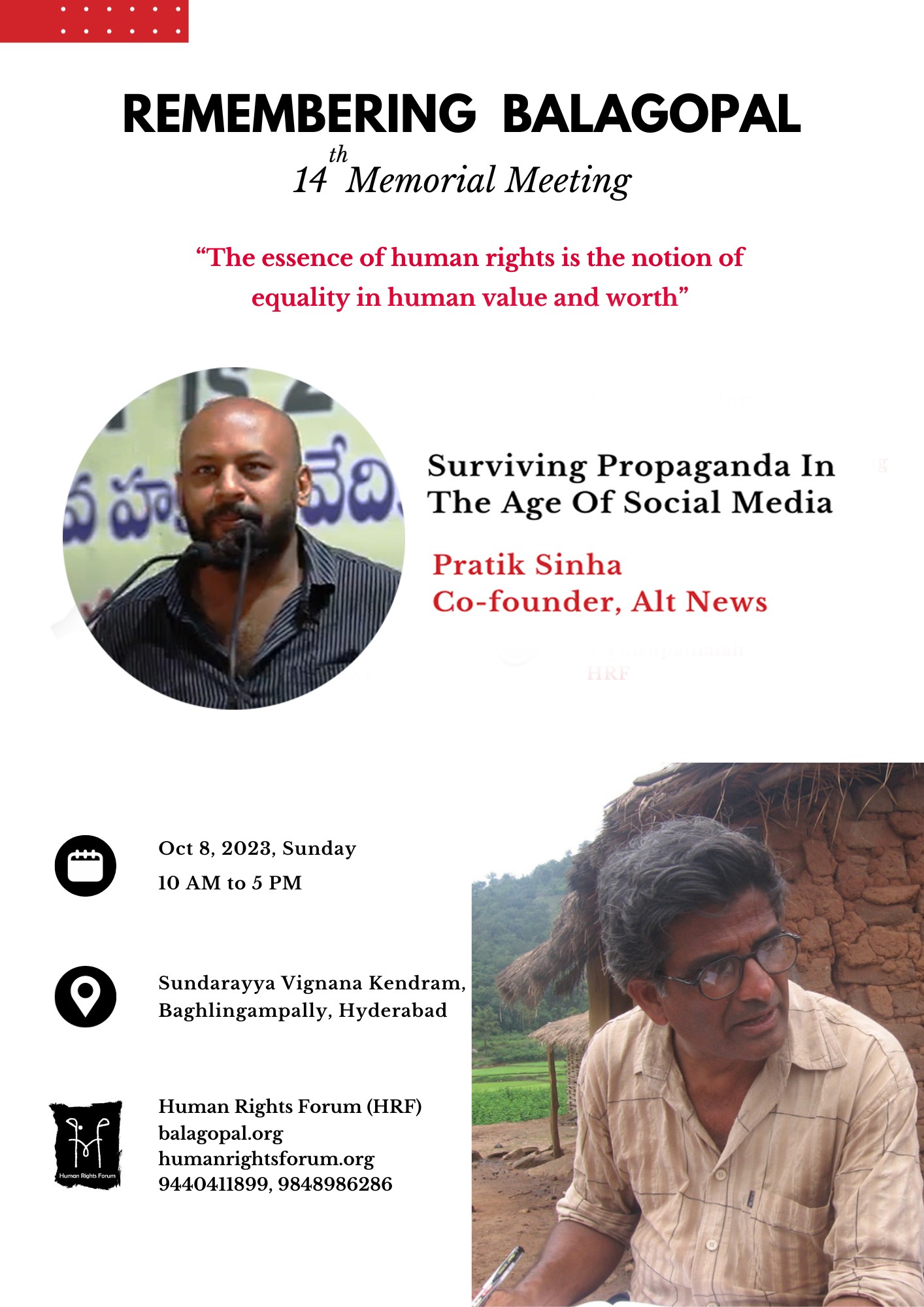Click the below link for the transcript of the speech
https://countercurrents.org/2018/10/of-cows-bacteria-and-human-rights/
Of Cows, Bacteria and ‘Human’ Rights – Satya Sagar
Countercurrents.org, 08/10/2018
This article is based on a talk delivered in Hyderabad on 7th October 2018 as part of the 9th memorial meeting of ‘Remembering Balagopal’, an annual event commemorating the late social activist K Balagopal
It is a truly a great privilege for me to be here today to speak to all of you at this meeting to remember Prof. Balagopal. I never knew him personally very well but of course read his writings and followed his work with great admiration. His wisdom, courage and compassion have been a source of inspiration to me and many, many others.
Let me tell you a little bit about myself. Over three and half decades ago I strayed into journalism by chance and worked in first the print and later television news medium in India and also abroad in South East Asia. From journalism I again strayed into the world of public health around two decades ago. In other words, I went from being a hack to a quack. Today when people ask me what exactly is your ‘field’, I tell them like Max Weber said many years ago when asked a similar question, “I don’t have any field, because I am not a donkey!”
In that spirit I will share with you today some of the insights into the subject of human rights I have gathered from my dabbling around in many disciplines – journalism, sociology, political science, microbiology, medicine and ecology.
The theme of my talk today is ‘Human Rights and Nature’, which is a very broad canvas indeed. Each of the three terms involved ‘Human’, ‘Rights’ and ‘Nature’ can be explored endlessly. I will try not indulge in too many theoretical abstractions but will touch upon a few sub-themes that may be of relevance to the overall idea of human rights.
A few questions that I want to discuss today are:
- What exactly is a human being? Do we really know or do we simply assume we know? How does our definition of what a ‘human’ is affect our idea of ‘human rights’?
- How do human perceptions of and interactions with Nature have an impact on relations within human societies?
- The character of human beings is contradictory and like Mother Nature itself – capable of great violence and cruelty but also immense compassion and nurture. How can we best ensure that what we call ‘human rights’ are actually respected and observed by humans?
Let me start by saying that one of the problems with the term ‘human rights’, I feel, is that it is a bit outdated in our age of rising ecological consciousness and climate change. The rights of human beings are very important of course, but it is becoming very obvious that we cannot really protect them without considering the rightful place of all other species, including planet Earth itself.
It is now eight years since a group of environmental and social movements from Latin America and other parts of the world gathered in Cochabamba, Bolivia to declare the Rights of Mother Earth. It recognises the Earth as a living being and states that “the planet consists of interdependent living communities and it is not possible to recognize the rights of only human beings without causing an imbalance within Mother Earth”.
As Eduardo Galeano, the great Uruguayan writer and poet said “Human Rights and the rights of Nature are two names of the same dignity. Human legs are also the road that Nature walks”. More recently, a few months ago, I was in Bolivia too as part of an effort to draft the Universal Declaration on Rights of Bacteria. Yes, Rights of Bacteria – those invisible living organisms that most people associate with disease.
More on that issue a little later, but the broad thrust of attempts to define and uphold the rights of Mother Nature or bacteria are essentially to say that in the larger scheme of evolution and our planet all species have equal right to exist. No individual species, including humans, can really claim to have an absolute right over the fate of any other species, whether plants, animals or insects.
We are all interdependent on each other, including as food sometimes and there is a need to maintain mutual respect and an overall balance. The key principle involved here is that if you take from Nature you should be willing to give back in equal measure or be ready to be taken by Nature too. It is a concept that is practiced only by some indigenous communities in some parts of the world.
Much of the so-called ‘civilized’ world only knows how to take more than its share and give back toxic wastes in return. In fact, the idea of ‘civilization’, equated currently with societies that make large constructions like the pyramids or the Taj Mahal, is highly questionable. Valuing dead buildings over people is more of like a real estate agent’s idea of what it means to be civilized, which should instead focus on how humans treat each other or living organisms around them.
The idea of human superiority or ‘intelligence’ over all other living creatures is also deeply mistaken. We are the only species on this Planet which has developed the capability of destroying all forms of life, including ourselves, several times over. Talking about human ‘intelligence’ therefore is as ridiculous as discussing the compassion of a suicide bomber! It is time to recognise that that humans are the problem and those who agree, need to initiate steps to make our species harmless to the future of our planet.
The Rights of Nature are now enshrined in the Constitutions of at least two countries – Bolivia and Ecuador. What this actually means in practice in these countries is a different question. Just as with human rights, the Rights of Nature have to be constantly fought for – but it is a great beginning to recognising that our Planet does not belong to humans alone and the future of our species is inextricably linked to the fate of all others.
Maybe in India, where the tradition of worshipping different aspects of Nature is deeply ingrained, a concept like Rights of Nature should not be difficult to understand and we should also promote this concept more widely. Adivasi communities, in particular have believed and still believe in the sacredness of forests, rivers, mountains, many animals, the sun, moon.
However, I also realize that without Adivasi communities winning their own political and social battles for survival and respect it is difficult to see how the Rights of Nature can be established more widely. In fact, the concept of Rights of Mother Earth emerged in the Andean region of Latin America after decades, if not centuries, of struggle of indigenous communities against colonialism, racism and the plunder of Nature by mining companies.
In our own times, the concept of the Rights of Nature in India faces a threat from both traditional and modern trends in Indian society. What we are currently living through in this country for quite some time is a very strange mix of the most regressive aspects of tradition combined with the worst aspects of modernity.
Let me point out that there is no shortage of great philosophy and wisdom that has been produced in India over the millennia. However, historically every noble idea or concept – from Buddhism to the Bhakti movement and anti-colonialism to Ahimsa, has been hijacked by those who run our societies to their own advantage.
Just to give one example, in mainstream Hindu society people worship many gods that have animals as their modes of transport –the mouse, peacocks, the bull, the tiger and so on. They also worship rivers like the Ganga, Narmada and Kaveri. In practice though, contemporary India shows a remarkable lack of real concern for anything to do with welfare of Nature. The filth that is dumped into all these ‘holy rivers’ on a daily basis is one instance of how much respect Indians have for the miracles of Nature around us.
The use of half-human, half-animal figures as deities in Hinduism is perhaps a result of the Adivasi influence on mainstream Hinduism long, long ago. But even this positive feature is shorn of any real empathy towards non-human species as far as practitioners of the religion goes in our times.
It has also always struck me as strange that though at least one Hindu god wears the head of an elephant, apparently done through plastic surgery in ancient times, there is little evidence of his ever having done anything for elephants anywhere. Every time elephant habitats are destroyed by logging companies or dam projects, I presume there must be elephants calling out to their closest relative in the pantheon of Hindu gods. And yet there seems to be no evidence of any real response from the deity – or I am sure sections of the Indian media – like Republic TV – would have surely reported it by now!
Forget about the Rights of Nature, in the Indian context, an even more fundamental problem is that the term ‘human’ itself does not have very deep roots. Traditionally in India, there were only two categories of two-legged creatures – there were the ‘devas’ and there were ‘asuras’. All the rights belonged to the ‘devas’ and none to the ‘asuras’ – who were to be terrorized and vanquished – using every devious method possible. The idea of a ‘human being’, with universal rights, still remains alien to much of India unfortunately – which makes the task of promoting ‘human rights’ very difficult.
Around a decade ago speaking at another gathering of human rights activists I remember saying, we should forget ‘human rights’ for some time and fight to get the same rights as the holy cow. If we get that, we are at least assured of not getting murdered arbitrarily and who knows you may even get some grass to eat and a place to sleep in the gaushala too. I was quite serious about what I said but my audience laughed then at what they thought was a far-fetched joke. Today it has turned out to be a frightening reality – cows indeed do have more rights than most human beings in this country.
But more recently I have also come to realize, it is no longer sufficient to just ask for the same rights as a cow in general either. It turns out that there is a caste system operating within with world of cattle also, with the certificates being distributed by the same fellows who run the caste system among humans! Foreign cows, half-breeds cows are out – only those cattle which can prove ancestry going back to the Vedic period can be considered to be worthy of worship. Only these truly ‘sanatani’ cows can have urine or dung bottled and sold as remedy for all ailments, including the falling rupee and rising cost of petrol! Cows straying over the border from neighbouring countries are particularly suspect – and can be deported if they don’t have national identity cards!
What I am of course pointing to is that, for all the worship of cows I don’t think any of its self-styled champions are really interested in their welfare. The cow is exploited all its life by the very same people who proclaim its holiness. Not just in India but around the world, I believe the story of cattle offers a very good model to understand how human interactions with other animal species has shaped social and economic relations within human societies. Let me explain.
Of all the different four-legged animals that humans have domesticated – the sheep, goats, dogs – it is the cow that is not just the largest in size and most useful but also the most docile. It is in fact amazing to think that these large animals, many of them with sharp horns, can be rounded up, tied up anywhere, fed grass or leaves at one end to obtain nutritious milk at the other end! And all this without any protest at all– even when the act of milking a cow is essentially theft of what rightly belongs to the calf, which is pushed aside casually (when was the last time you heard of a ‘revolutionary cow’?).
I want to reflect a bit on this human interaction with cattle because I think this is the original template for most of human relations, from time immemorial. Once the cow was tamed the idea must have surely arisen in some man’s head –if such a large animal can be so easily turned into a slave – why not women, children and members of the neighbouring tribe? Can’t they all be made to work for free or at bare subsistence levels – without any protest – just like the cow?
So in the world we live in this is how the ‘cow model’ operates. There are the chosen few who are ‘cowboys’ and the rest of humanity are supposed to be ‘cattle’. If you accept being a cow you will be given your daily subsistence and even worshipped before being milked. And if you refuse to be ‘cowed’ down, you will be called all kinds of names and subjected to violence, torture or even death.
The problem of human rights violations comes from this fundamental attempt of some people to try and convert all others into cattle or slaves. Since many humans are not exactly cows and capable of some thinking there are also other strategies, apart from raw violence, used to achieve the same objective. These include imposing blind faith in the form of various religions or ideology; education that teaches you not to think at all; entertainment that numbs you like a narcotic and finally the magical lure of money, which blinds you to everything you may have learnt.
The cities we live in, factories, banks, schools, colleges, religious places, governments and other institutions – in one way or the other – all are manipulated to ensure that ordinary citizens get converted into cattle. We are indeed all living in one very large cattle shed and I see many, many cows and bulls walking on two legs all around and even talking on their smart phones. When the media sometimes claims we need a stable government or a stable economy – the term ‘stable’ I think has a different meaning from what is commonly assumed!
Recently I figured out that this ancient cow template is critical to the functioning of modern societies also. We know that cattle were considered as good as money and synonymous with wealth for a very long period of time in history. In the English language the term ‘pecuniary’, which means anything related to money, is derived from the Latin root ‘pecu’, which in turn means cattle. Again, the word ‘chattel’, that refers to personal property and is the precursor of the word ‘capital’ is also derived from ‘cattle’. So when we say ‘capitalism’, to refer to the exploitative economic system we are part of in modern times, there is still the holy or unholy cow at the heart of the entire story!
In modern times, another problem we have is that, in all our dealings with Nature around us we use the techniques of engineering, which is a discipline that involves only the manipulation of dead objects but is indifferent to the fate of living ones. In engineering there is no space at all for uncertainties of any kind – which happens to be the chief characteristic of living organisms. An engineer is used only to dead certainties and when confronted with something living his impulse is to translate it into a corpse.
The cult of engineering is so deeply entrenched in modern societies that today we don’t have politicians, doctors or journalists anymore – instead we have political engineers, medical engineers and data/information engineers – who don’t really care what happens to real flesh and blood people because of their actions. And as for non-human living organisms there is even less concern for their fate in the world of engineering -even their genocide is presented as a routine part of the modern development process.
I work in the area of health on the theme of ‘bacterial resistance’, which is essentially the problem of antibiotics not working very effectively anymore because some genetic variants of infectious bacteria have become immune to their impact. This is a result of using antibiotics in large quantities over the last several decades since these ‘miracle drugs’ were discovered. This is a ‘problem’, of course, only for human beings but not for the bacteria themselves, who are doing what every living organism wants to do – survive.
However, looking into this phenomenon a bit more deeply one realizes that antibiotics were an indiscriminate and blunt weapon of war, used by humans to try and control bacterial infections.It was assumed that once we have identified a problem as being due to bacteria it is OK to kill all of them indiscriminately using antibiotics or whatever other poison we have at hand, irrespective of the long-term consequences.
The simple truth is that bacteria are not just the oldest but also the most numerous form of life on our planet. They are our ancestors in the tree of life. However, despite their amazing diversity and being indispensable to the existence of all life on Earth, bacteria are presented as being nothing more than disease-causing organisms.
Yes, bacteria do cause disease but that is only a very, very small fraction of the things they do. There is no important process on our planet that is not driven or mediated by bacteria – from photosynthesis, to the fixing of nitrogen in soil to waste recycling and the digestion of the food that all living creatures eat – and yet it turns out that bacteria are projected as pure villains who are only out to kill human beings.
The problem with building a hierarchy of life forms on our planet, with humans assumed to be at the top is that very quickly this becomes the model for ordering human societies themselves. The closest analogy to the extremely prejudiced view of bacteria in the Indian context is the caste system in Hindu society, which has historically made the contributions of the vast majority of Indians who do not happen to be ‘twice born’- completely invisible.
Going by the colorful mythology that is passed off as history in this country it would seem just a handful of upper caste Hindus – and that too only men – built the great civilizations of India. These very clever men, not just composed the Vedas, Upanishads and the Puranas they also did everything from cooking and carpentry to weaving, farming and milking cows. Perhaps they even gave birth to babies, breastfed them and washed their behinds.
Let me say here that this inability to acknowledge the role played by organisms like bacteria and many other species in the sustenance of life on our planet cuts across ideologies and is part of a blindness that comes with modernity itself. When Karl Marx famously said ‘Workers of the World Unite’, he was very right except that the idea of the ‘working class’ should have included many other species, apart from humans, which contribute to production of goods essential to our survival. Try growing food without bacteria and you will know what I mean. Hopefully, any future idea of socialism will go beyond just humans in its vision of a world without exploitation.
The idea that bacteria have no right to exist whatever and their deaths are completely inconsequential is part of the engineering mindset that has gripped much of humanity like a disease on its own. This mindset has had terrible consequences for how humans have behaved with other humans in modern history.
It is not a coincidence that the Nazi regime of Adolf Hitler back in the 1930s called the Jews ‘vermin’- which refers to creatures like rats, cockroaches, wild animals – which were all considered to be ‘pests’ to be eliminated without hesitation. And as part of this strategy the Nazis very calmly and efficiently killed over 6 million Jews in their gas chambers and concentration camps. The idea of ‘pest control’ lies at the heart of modern fascism.
Just a couple of weeks ago, the very weighty President of a national political party, one that happens to be in power, called migrants from Bangladesh, allegedly ‘infiltrating’ India, as ‘termites’ – using a language similar to that used by the Nazis against Jews. I have no doubt that he has similar intentions of genocide against them too. The only saving grace could be that Indian engineers, in my view, are incapable of building gas chambers that will not leak from all sides. It is the inefficiency of our rulers, not the lack of murderous intentions, that has prevented a completely fascist takeover of India as yet.
However, I have another problem also with Mr Amit Shah’s use of ‘termites’ as something assumed to be ‘bad’ or ‘worthy of elimination’. What does he know about termites at all that he talks about them in such a negative manner? Does he know that termites play a critical role in all ecological systems by removing waste wood and recycling them back into the soil? Does he know of the elaborate social mechanisms that termites have or the way they move mountains of soil to build their anthills? Does he know these anthills are actually marvels of engineering, operating a sophisticated air-conditioning system that helps millions of them live under the ground?
Yes, it is true that termites destroy property but what’s wrong with that? Termites emerged well before humans did and have equal if not more right to all property on our planet. The activity of termites is damaging to human settlements, but they are only one of the many ways in which Nature constantly reminds the human species that nothing lasts forever in this world. In a way termites are almost Nature’s own Buddhists – teaching all of us a lesson how impermanence is the essence of the Universe itself. Too bad if you used dead wood to decorate your new apartment!
Friends, we are gathered here at a time when not just India but the entire globe seems to be in the grip of conflict, rising inequalities, sectarian hatred, ecological destruction and predictions of doom about the future of our planet itself. As I have tried to point out here today – while it is not the only factor- the arrogance of humans in their presumed conquest of Nature and other species is certainly one of the reasons for the misery we see around us today
I however think that looking at the world around us from an ecological perspective can help us figure out a way forward. We all understand that as individuals, we humans, are part of the same ecological cycles of birth, life and death like all other forms of life. In my view, this is true of entire human societies also. They too are part of large ecological cycles – there are periods of relative peace and prosperity and then there are times of great conflict and destruction.
Just as we talk of life expectancy of individuals, there is a life expectancy also for societies and even ideas. They are born, survive, thrive, grow old, get diseased and then dissipate or even disappear.
Take the example of the Indian Republic, which is now nearly 70 years old, an age very similar to the average life expectancy of citizens of this country. Like Indians of this age our Republic too suffers from various ailments– it is diabetic, has poor eyesight, its joints are painful and if one goes by some recent Supreme Court judgments, it is also seems quite constipated.
I do foresee terrible times ahead for the Indian Republic. The chances of its surviving another 70 years or even 20 are doubtful given the forces that are tearing the nation apart. Over the decades, there has been a steady erosion of institutions, integrity, trust, shared resources – the future of this Republic has been stolen in front of our eyes by the very people responsible for its protection.They hold on to power by keeping ordinary citizens in an abject state of poverty, through state repression, promoting communal division and the violation of their very right to exist.
However, I do not think there is any point in lamenting what is happening as in all living systems decay is inevitable, even in the best of them. It is more useful to ask ourselves what we can do to recycle this waste all around us, produce good quality compost, plant new seeds and make the social and political soil of this ancient land fertile for the flowering of life once again.
While we are not their holy cows to be worshipped or whipped into submission, milked and abandoned, not all of us can be like lions and tigers either to fight back with individual strength. Most of us are very small, just like bacteria and termites, but as explained before that is not such a bad thing at all. We also have the numbers and the capacity to turn all forms of rubbish into life-giving soil.
Small is not just beautiful, it can also be very powerful – provided we get organized and recognize our own collective strength. To our rulers we are bacteria, representing filth and dirt, that they would like to clean up, but we are the sources of all life forms on this planet and it is time we take back the Earth from the parasites that are devouring our present and future.
Satya Sagar is a public health activist and writer. He can be reached at [email protected]










